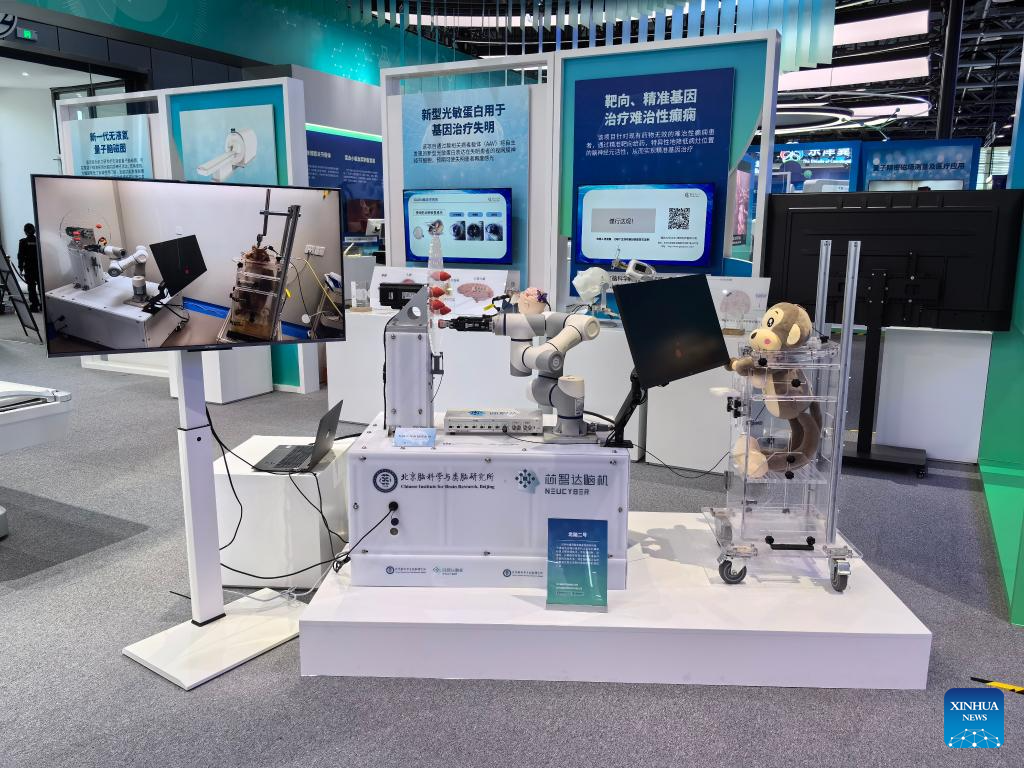
This photo shows the NeuCyber Array BMI System, a self-developed brain-machine interface (BMI) system from China, unveiled at the opening ceremony of the 2024 Zhongguancun Forum in Beijing, capital of China, April 25, 2024. (Xinhua)
BEIJING, April 26 -- The NeuCyber Array BMI System, a self-developed brain-machine interface (BMI) system from China, was unveiled at the opening ceremony of the 2024 Zhongguancun Forum (ZGC Forum) on Thursday in Beijing.
At the forum, a video demonstration revealed a remarkable feat: a monkey with its hands restrained and soft electrode filaments implanted in its brain, controlled an isolated robotic arm and grasped a strawberry by simply using its "thoughts."
The NeuCyber Array BMI System fills the gap in high-performance invasive brain-machine interface technology in China, said Luo Minmin, director of the Chinese Institute for Brain Research, Beijing, which co-developed the system with NeuCyber NeuroTech (Beijing) Co., Ltd.
The BMI serves as the "information highway" for the brain, facilitating communication with external devices and providing cutting-edge technologies in human-machine interaction and hybrid intelligence, Luo said.
"In short, the technology captures the subtle changes of electrical signals from neurons and decodes the brain's intentions, to realize 'thoughts' control 'actions'," he said.
The NeuCyber Array BMI System is composed of three major components -- high-throughput flexible microelectrode array, a thousand-channel high-speed neural signal acquisition system, and a generative neural decoding algorithm based on a feedforward control mechanism.
The electrodes determine the quality of the recorded brain signals and the accuracy of "brain control," said Li Yuan, business development director of NeuCyber NeuroTech (Beijing) Co., Ltd. The NeuCyber Array BMI System makes use of a large number of electrode contacts on a thin electrode thread to enhance signal capture ability.
The electrode filaments made of flexible materials needed to be viewed under a microscope, said Li. The material, which boasts high biocompatibility and no cytotoxicity, fits well with brain tissue.
"Both its number of effective channels and long-term stability are up to the international state of the art," Li said. "Different from stiff electrodes, the flexible microelectrode array can still effectively record brain signals after one year of implantation in the brain of macaque monkeys."
The generative neural decoding algorithm based on the feedforward control mechanism of the system can establish an accurate mapping between neural activity in the cerebral cortex and motion parameters.
"BMI system focuses on safety, stability and effectiveness. It's a systematic project," said Luo, adding that the invasive BMI has a long chain of development, involving multiple technologies such as electrodes, chips, algorithms, software, and materials. There is still a long way in technological refinement and iteration.
Founded in 2007, the ZGC Forum, with its enduring focus on innovation and development, has evolved into a national-level open innovation platform and an international forum over the years.












